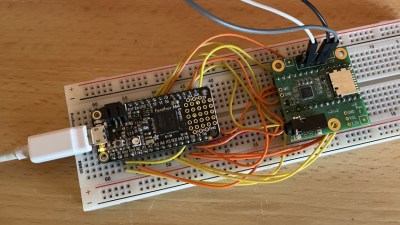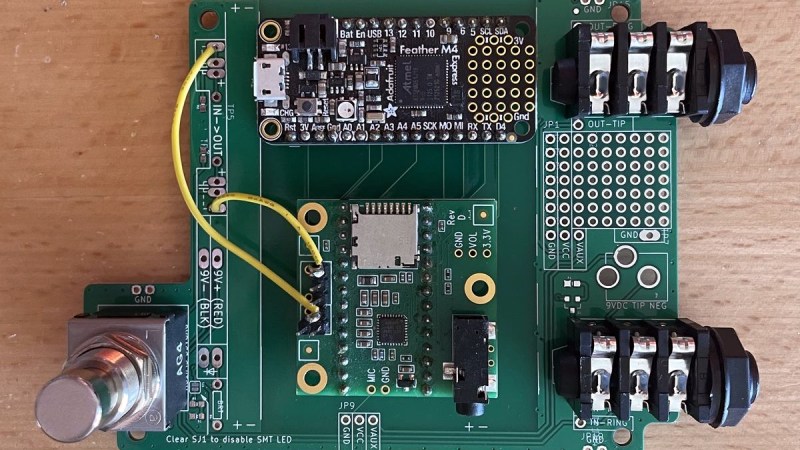Ever wondered how to approach making your own digital guitar effects pedal? [Steven Hazel] and a friend have done exactly that, using an Adafruit Feather M4 Express board and a Teensy Audio Adapter board together to create a DIY programmable digital unit that looks ready to drop into an enclosure and get put right to work in the studio or on the stage.

[Steven] also made a custom PCB to mount everything, including all the right connectors, but the device can be up and running with not much more than the two main parts and a breadboard.
On the inside, the Adafruit Feather M4 Express board works with the audio board over I2S, a standard for sending serial digital audio between chips. Working with the audio itself is done with the Teensy Audio Library, providing a fantastic array of easy-to-use functions for processing and manipulating digital audio streams.
Together, all the right pieces are in place and [Steven] provides the code for a simple tremolo effect as a glimpse of what’s possible with the unit. Interested in going a bit further? [Steven] shares additional details about what’s involved in writing a custom effect from scratch using the Teensy Audio Library.
As mentioned, I2S is where it’s at when it comes to working with digital audio at the chip level, and our own Jenny List can tell you everything you need to know about I2S, a useful protocol that has actually been around since 1982!















maybe this would be interesting for such a thing:
http://www.spinsemi.com/products.html
There’s also Blackstomp made with an ESP32 https://www.deeptronic.com/blackstomp/
and Electrosmash has several different Arduino (Uno, Mega, DUE) and Pi based pedals https://www.electrosmash.com/
And there is of course daisy seed which is a very powerfull audio platform;
https://www.youtube.com/watch?v=ozR6KUJYqXk
https://github.com/jerry20091103/Daisy_Guitar_Pedal
It’s time for the guitar and such to really become electric and build in the FX! The floor is a poor working space unless you’re a dancer. Get on board because of the small size, lithium power, and knobs we can have at our fingertips. These projects hold my interest but Rakarrack on a free computer is real good, but not to build in yet.
Not a guitar player i guess.
What do you think guitarist do with their finger tips during playing? A wahwah controlled by what? Looking at the ground to press the right button with your feet mid-solo is way easier than with small buttons on a small space, with a bad view angle.
Think I’ve had this bookmarked forever. https://www.electrosmash.com/pedalshield
Thank you for posting that. Spend an entire afternoon going down the effects pedal rathole! Also came across this interesting commercial product: https://line6.com/pocket-pod/
Does the Teensy audio library support more than 16-bit audio yet? 16-bits may be fine for CD-quality music, but it does not have enough dynamic range for the kind of signals things like electric guitars might send in, and then there’s doing DSP-type stuff, where 48 to 96 bits is common. I suppose you could do it hacky with analog companders – this is how BBD-type delay/chorus stuff copes with live dynamic range.
It seems like I2S would be a great starting point for putting together digital effects chains. Except that little bit where it is just single-ended digital, without any standard for line drivers or receivers – everything is expected to be on the same PCB. So if you want to make a bunch of separate pedals, you have to do ADC and DAC on each pedal. Of course, if you have multiple effects in a single pedal, you can daisy chain a number of MPUs to do this, using the I2S connections on each. They just have to all be in the same box. That, or maybe a physical interface such as RS485 could be used, keeping it all digital but allowing interconnection between pedals with Cat5 cable.
Whatever happened to those field programmable analogue array chips researchers were developing? Would be perfect for such applications, and making eurorack modules.